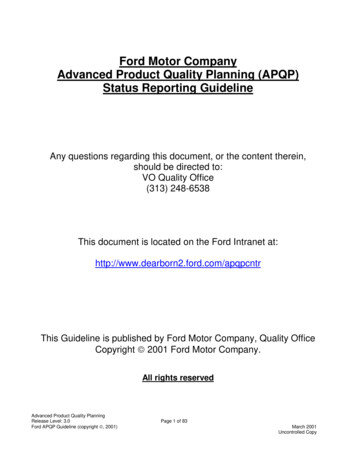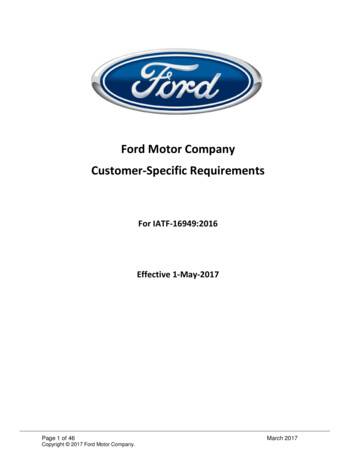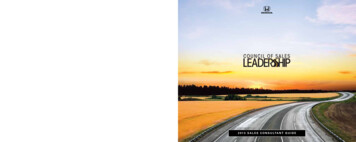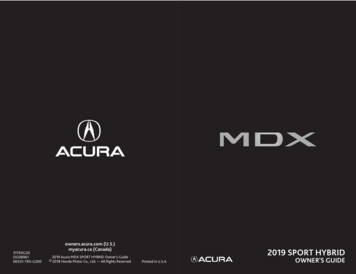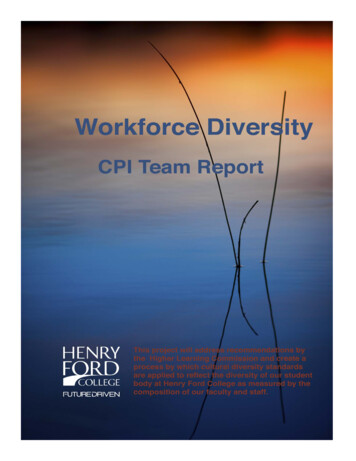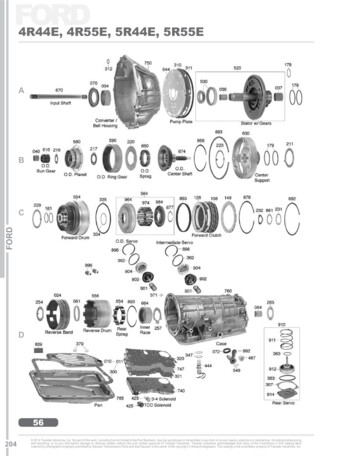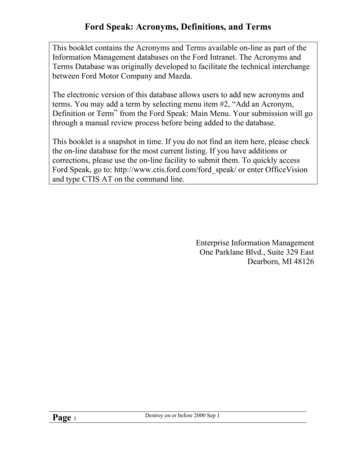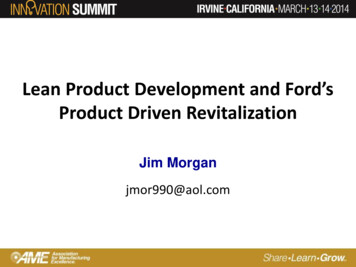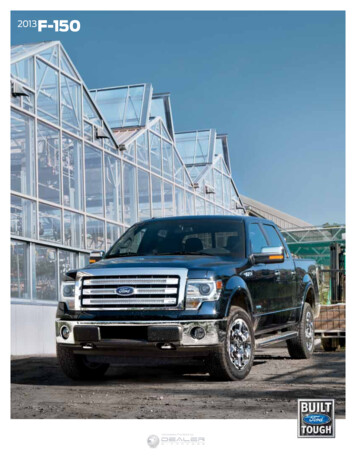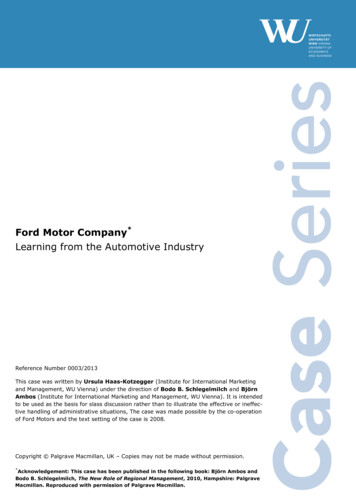
Transcription
Ford Motor Company*Learning from the Automotive IndustryReference Number 0003/2013This case was written by Ursula Haas-Kotzegger (Institute for International Marketingand Management, WU Vienna) under the direction of Bodo B. Schlegelmilch and BjörnAmbos (Institute for International Marketing and Management, WU Vienna). It is intendedto be used as the basis for slass discussion rather than to illustrate the effective or ineffective handling of administrative situations, The case was made possible by the co-operationof Ford Motors and the text setting of the case is 2008.Copyright Palgrave Macmillan, UK – Copies may not be made without permission.*Acknowledgement: This case has been published in the following book: Björn Ambos andBodo B. Schlegelmilch, The New Role of Regional Management, 2010, Hampshire: PalgraveMacmillan. Reproduced with permission of Palgrave Macmillan.
IntroductionIt is Thursday, 8 p.m., and Peter Burger is still in the office going through his presentationfor tomorrow’s meeting. It was two weeks ago, that he received an urgent telephone callfrom his boss to meet in his office immediately.Mr. Burger started working with Ford of Europe in 2006, the year when Ford reported oneof the worst losses in the companies’ history. Being part of the corporate strategy team inEurope and working as assistant to the head of this team, Mr. Burger found himself soonin the middle of a restructuring process called the “Way Forward Initiative”. The initiativewas started by Bill Ford and will be continued by the new CEO, Alan Mulally, who succeeded Bill Ford in September 2006. The aim is to restructure the operations of Ford Motorsand bring it back into making profit. Ford was going through a troubled phase starting in2000. Especially in the US market, Ford was facing a tremendous downward trend. Fordecades, Ford concentrated its effort on selling SUV’s and Pickups and built its reputationon manufacturing big trucks, selling big cars with big engines. It left the growing segments of manufacturing small and medium-sized cars to its foreign competitors. As a result of the increase in the oil prices, the demand for small and medium-size cars was increasing. Ford somehow missed that trend. Although Ford made changes to the productportfolio recently, it will take time to shift the image in consumers’ minds. In addition, badnews on the company’s financial performance has not helped Ford s reputation.Together with his boss, Mr. Burger was assigned to prepare a presentation for the Boardof Ford of Europe. Given the current economic situation and its impact on the automotiveindustry, the board meeting was planned to discuss the position of Ford of Europe withinthe organization and its future strategy. The board meeting is scheduled for Friday morning. Reflecting on tomorrow’s meeting made Mr. Burger shiver, he knows that the presentation and their recommendations will be of major importance to the European Board. So,he starts going through the facts and figures once again to make sure that he presents arealistic picture of the current situation of Ford of Europe and provide steps regarding thestrategic directions for the future.Company BackgroundSince its establishment in 1903, Ford has successfully developed its position in the globalautomotive industry, ranking among the top of the world’s biggest car manufacturer.It manufactures and distributes automobiles in over 200 markets across five continents.Ford primarily operates in the US and Europe with 95 plants worldwide. It is headquartered in Dearborn, Michigan, and employed 246,000 people as of December 2007.The company recorded revenues of 172,455 million in fiscal year up to December 2007,an increase of 7.7 per cent over 2006. The operating profit of the company was 5,631million in fiscal year 2007, as compared to an operating loss of 8,190 million in 2006.The net loss was 2,723 million in 2007, compared to a net loss of 12,613 million in2006.iFord is divided into two businesses: the automotive division and the financial service division.1
Automotive DivisionIn the automotive business Ford produces a variety of vehicles, among them cars for thesmall, medium, large and premium segment as well as trucks, buses, vans and SUV’s. Thecompany's automotive vehicle brands include Ford, Jaguar, Lincoln, Mazda, Mercury andVolvo. It also owns a 33.4 per cent controlling stake in Mazda. Following the consumertrend towards smaller and more economical cars, Ford has increased its business in thissegment. The automotive business is organized into five segments: Ford North America,Ford South America, Ford Europe, Premier Automotive Group (PAG), and Ford Asia Pacific&Africa and Mazda. In addition to manufacturing and selling cars and trucks, Ford alsoprovides a variety of after-sales services and products through its dealer network.Financial Service DivisionThe financial service division, Ford Motor Credit Company, was established in 1923 as awholly owned subsidiary of Ford. It provides automotive financing for Ford, Lincoln, Mercury and Volvo dealers and customers. Ford Credit was established so Ford Motor Company dealers could provide competitive financing services to both individuals and businesses.The key financial services include: retail financing, wholesale financing and third-partyclaim management services. The revenues of the two divisions in FY 2007 were split asfollows: automotive (89.5 per cent) and financial services (10.5 per cent)ii.HistoryFord Motor Company was established in 1903 by Henry Ford and 11 business associates.At that time, the US was home of 87 other car companies. Before Ford, cars were luxuryitems, very expensive and only affordable by the wealthy. Ford’s genius was to recognizethat with the right technology, cars can be made available to the public at an affordableprice. He focused on making the process more efficient and as a result produced morecars and charged lower prices. Within short time Ford became an innovative and one ofthe most successful car-producers of the US.After 20 years of experimentations, the company launched its first model “T”, also knownas “Tin Lizzie” in 1908. It was a powerful car with a possible speed of 45 mph. It could run25 miles on a gallon of gasoline. It carried a 20-horsepower, side-valve four-cylinder engine and two-speed planetary transmission on a 100-inch wheelbase.But some of Ford’s greatest innovations were not in cars themselves but in the manufacturing process. In 1914, he introduced a moving conveyor belt at the Highland Park plantwhich led to a dramatic increase in production. As a result, in 1914, Ford produced308,162 cars, more than all other automakers combined, thus making Ford the inventor ofmass production.In 1917, he set the first step toward an all-in-one manufacturing complex, where the processing of raw materials, parts and final automobiles could happen efficiently in a singleplace. Also in 1917 the company began producing trucks and tractors.In 1919, after a conflict between Henry Ford and the stockholders, several investors leftand the company became wholly owned by the Ford family.2
In 1922, Ford bought Lincoln Motor Company, named after Abraham Lincoln, for 8 million. Lincoln became the first "outsider" to join the Ford family of vehicle brands and initiated the company's entrance into the luxury market.In the mid 1950s, Ford went public. In the same decade, Ford introduced the legendaryFord Thunderbird at Detroit’s first auto show after World War II. The two-seated sportscar became a legend and grew with each generation during the next five decades. Thunderbird went through several design changes with coupes, sedans, convertibles, hardtops,and mid-size and large-size configurations. It went on hiatus after the 1997 model year,but returned in 2001 as a retro-styled roadster.The global expansion of Ford was intensified in 1960s when the company established FordEurope in 1967. The “North American Automotive Operations” was established in 1971,consolidating the operations in the US, Canada and Mexico. Throughout the 1970s and1980s the expansion continued with further moves into Europe and Asia.In 1987, Ford helped to form the Park Ridge Corporation in order to acquire the Hertz carrental business. Seven years later, Ford increased its stake in Hertz to 100 per cent. During the 1990s, as a result of the growing US economy and the low fuel price, Ford succeeded in selling a large number of vehicles in the home market. Also in the 1990s, thecompany acquired Jaguar and Land Rover.The presence in China and Thailand was further extended during 2002 und 2003. In 2004,Ford signed a deal with the Chinese government to secure rights to land in Nanjing, wherethe company plans to build a second Ford plant in China. In 2005, Ford took full control ofits operations in India with the purchase of a nearly 16 per cent stake from its partner,Mahindra & Mahindra Ltd. Ford Motor had set up its Indian subsidiary in Madras in 1995 asa 50-50 joint venture with Mahindra.However, in the 2000s Ford experienced a downwards trend in its performance. The slowing economy, an increase in the fuel price as well as its product mix - the focus on fuelintensive passenger cars - led to a decrease in sales.Also in 2000, Ford was facing a major loss of reputation. Firestone tires that were fitted toall Ford Explorer vehicles were tipping and causing accidents. Bridgestone/Firestone recalled more than 6.5 million tires after more than 200 rollover deaths in Ford Explorers.The tires exploded while the vehicle was moving; as a result the SUVs lost control. Fordrecalled another 13 million tires in 2001. As a consequence, Firestone/Bridgestonedumped Ford as a customer and accused the company of using Firestone/Bridgestone as ascapegoat to deflect attention from the Ford Explorer. Ford’s cost for the product recallssummed up to 2 billion US . After Federal investigators concluded that the tire defectswere the main cause for the rollovers, Firestone/Bridgestone decided in 2005 to pay FordUS 240 million to help cover the costs of the recalls. However, as a consequence thereputation and credibility of Ford sank and the public lost confidence in the companyiii.In addition, major product recalls on Mazda in 2004 and Ford pickup trucks and SUVs in2005 contributed to the negative trend the company was facing.3
MarketsGlobal OperationsFord Motor Company has organized its automotive business activities into five segments:Ford North America, Ford South America, Ford Europe, Premier Automotive Group (PAG)and Ford Asia Pacific and Africa/Mazda. Ford is therefore divided into geographical regionson the one hand and separates its Ford brands from luxury brands on the other hand.Whereas Ford Europe sells Ford brand vehicles and related service parts in Europe, Turkeyand Russia, PAG - also located in Europe - sells its luxury brands (Volvo, Jaguar and LandRover) throughout the whole world.Table 1 illustrates the global market share of automobiles; Ford Motor Company is currently ranked on fourth position.Table 1: Global market share, 2008Company % Share, by Value, 2008Toyota Motor Corporation12.80%General Motors Corporation8.90%Daimler AG8.10%Ford Motor Company7.80%Other62.40%Total100.0%Source: Datamonitor, Global Automobiles, 2009, p 13During the FY 2007, the automotive division of Ford recorded revenues of US 154,379million, an increase of 7.8 per cent vs. 2006. North America, the largest geographic market, reached US 93,063 million ( 0.5 per cent vs. 2006) and accounted for 54 per centof total revenues in 2007. In comparison, Europe accounted for 34.8 per cent of total revenues in 2007. Revenues in Europe increased by 19.9 per cent and reached US 60,044 in2007. Other regions accounted for 11.2 per cent of total revenues in 2007. Revenuesreached US 19,348 million, an increase of 11.5 per cent over 2006.iv4
Figure 1 illustrates the revenues by Geography in 2007:Revenues by Geography, 200711.2%54.0%34.8%North AmericaEuropeothersSource: Datamonitor, Ford Motor Company, November 2008, p 18.Table 2 provides an overview of Ford’s core and affiliates brands, the retail vehicle salesper brand and the presence in the various regions. Whereas the Ford brand is sold in every region, Lincoln and Mercury are purely North American brands and almost unknownoutside North America. Volvo and Land Rover have a strong presence in Europe, whereasthe focus of Mazda lies in the region of Asia Pacific.Table 2: Automotive Core and Affiliate BrandsSource: Ford Motor Company / 2007 Annual Report, p 1295
North AmericaFord North America represents the most important geographical region within the company, accounting for more than 50 per cent of total revenues. The North America businessincludes the United States, Canada and Mexico.Although Ford belongs to the key players in the U.S. automobile industry, it has been losing market share in the past five years. Ford’s overall market share in the U.S. has declined from 20.5 per cent in 2003 to 14.7 per cent in 2008. This downwards trend wasprimarily a result of increased competition, an industry shift away from Ford’s traditionallystrong segments (for example SUV’s and pickups) and the discontinuation of a number ofcompany’s vehicle lines over the last couple of years.vFigure 2 illustrates the market share within the U.S. market in 2008. The U.S. market isdominated by the “Big Three” national manufacturers General Motors, Ford and Chrysler,which account for approximately 48 per cent of the market. The “Big Three” are heavilychallenged by Japanese producers, which already account for more than 30 per cent of theU.S market.Compared to 2005, when Ford was ranked Number two with 18.2 per cent market share,Ford lost one rank in 2008. Toyota increased its market share over the last years from13.0 per cent in 2005 to 16.4 per cent in 2008 and overtook Ford, who is now rankednumber three (14.7 per cent in 2008). GM is market
was started by Bill Ford and will be continued by the new CEO, Alan Mulally, who succeed-ed Bill Ford in September 2006. The aim is to restructure the operations of Ford Motors and bring it back into making profit. Ford was going through a troubled phase starting in 2000. Especially in the US market, Ford was facing a tremendous downward trend. ForFile Size: 1MBPage Count: 21



